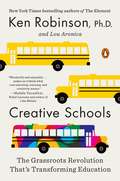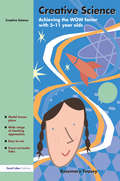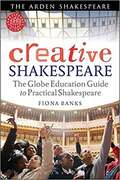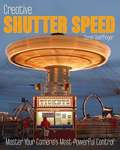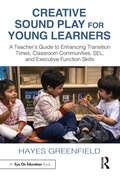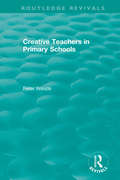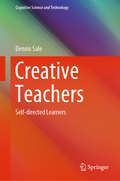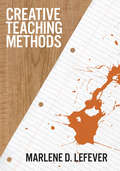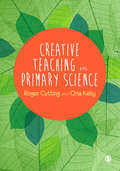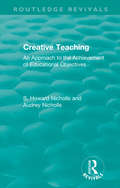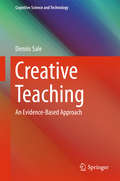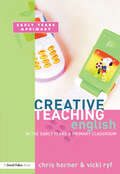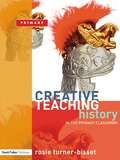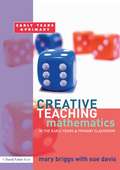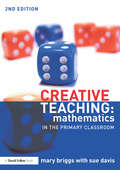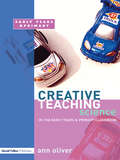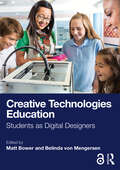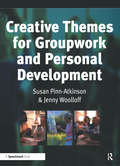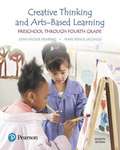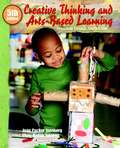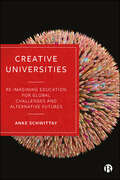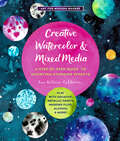- Table View
- List View
Creative Schools
by Lou Aronica Ken RobinsonA revolutionary reappraisal of how to educate our children and young people by Ken Robinson, the New York Times bestselling author of The Element and Finding Your Element Ken Robinson is one of the world's most influential voices in education, and his 2006 TED Talk on the subject is the most viewed in the organization's history. Now, the internationally recognized leader on creativity and human potential focuses on one of the most critical issues of our time: how to transform the nation's troubled educational system. At a time when standardized testing businesses are raking in huge profits, when many schools are struggling, and students and educators everywhere are suffering under the strain, Robinson points the way forward. He argues for an end to our outmoded industrial educational system and proposes a highly personalized, organic approach that draws on today's unprecedented technological and professional resources to engage all students, develop their love of learning, and enable them to face the real challenges of the twenty-first century. Filled with anecdotes, observations and recommendations from professionals on the front line of transformative education, case histories, and groundbreaking research--and written with Robinson's trademark wit and engaging style--Creative Schools will inspire teachers, parents, and policy makers alike to rethink the real nature and purpose of education.From the Hardcover edition.
Creative Schools: The Grassroots Revolution That's Transforming Education
by Lou Aronica Ken RobinsonA revolutionary reappraisal of how to educate our children and young people by Ken Robinson, the New York Times bestselling author of The Element and Finding Your Element Ken Robinson is one of the world's most influential voices in education, and his 2006 TED Talk on the subject is the most viewed in the organization's history. Now, the internationally recognized leader on creativity and human potential focuses on one of the most critical issues of our time: how to transform the nation's troubled educational system. At a time when standardized testing businesses are raking in huge profits, when many schools are struggling, and students and educators everywhere are suffering under the strain, Robinson points the way forward. He argues for an end to our outmoded industrial educational system and proposes a highly personalized, organic approach that draws on today's unprecedented technological and professional resources to engage all students, develop their love of learning, and enable them to face the real challenges of the twenty-first century. Filled with anecdotes, observations and recommendations from professionals on the front line of transformative education, case histories, and groundbreaking research--and written with Robinson's trademark wit and engaging style--Creative Schools will inspire teachers, parents, and policy makers alike to rethink the real nature and purpose of education.From the Hardcover edition.
Creative Science: Achieving the WOW Factor with 5-11 Year Olds
by Rosemary FeaseyThrough a refreshing blend of theory and practice this book provides stimulating material to develop creative approaches to science in the classroom. It includes: a range of teaching approaches that relate directly to the topic under discussion examples of pupils' work that portray how theory can be translated into practice quick off-the-shelf example model lesson plans which can be adapted. User-friendly and clearly laid out this book is a core text for primary teachers, NQTs and students who want to inject some creativity into their teaching and put that "WOW" factor back into their science lessons.
Creative Shakespeare: The Globe Education Guide to Practical Shakespeare
by Fiona BanksThis unique book desribes the ways in which educational practitioners at Shakespeare's Globe theatre bring Shakespeare to life for students of all ages.The Globe approach is always active and inclusive - each student finds their own way into Shakespeare - focusing on speaking, moving and performing rather than reading. <p><p>Drawing on her rich and varied experience as a teacher, Fiona Banks offers a range of examples and practical ideas teachers can take and adapt for their own lessons. The result is a stimulating and inspiring book for teachers of drama and English keen to enliven and enrich their students' experience of Shakespeare.
Creative Shutter Speed
by Derek DoeffingerA unique guide to creative shutter speed techniques, illustrated with striking full-color examplesAlong with available light and aperture, shutter speed is one of the variables that determine exposure-the amount of light that reaches the camera's sensor. Set on automatic modes, cameras typically attempt to reduce or eliminate blur in a picture. But by manipulating shutter speed creatively, photographers can achieve a range of striking motion blur or stop-action effects. Using an array of inspiring photographs depicting people, wildlife, and landscapes, Creative Power of Shutter Speed explains how to "read" the light and movement in a potential photograph and identify the best shutter speed for the desired effect.
Creative Sound Play for Young Learners: A Teacher’s Guide to Enhancing Transition Times, Classroom Communities, SEL, and Executive Function Skills
by Hayes GreenfieldThis fun and engaging guide invites you to use sound-making as a collaborative, play-based practice in your early childhood classroom—first to transform tricky transition times and ultimately to support your children’s executive functioning development and social-emotional learning. The book offers techniques and ideas for every teacher to reach every child in their classroom including verbal, nonverbal, and special needs children. Easy to integrate into all standard early years curricula, it focuses on three basic elements of sound: pitch, volume, and duration. The book features an "overview of the school year" calendar and an implementation guide, in addition to a variety of suggested sound-making activities that start out simply and, through the course of the book, expand to engage children’s creativity in more dynamic ways. Creative Sound Play for Young Learners is key reading for any preschool teacher, leader, or parent.
Creative Strategies to Transform School Culture
by John F. Eller Sheila A. EllerThe authors present practical, proven strategies to improve school culture, including activities for developing collaborative work relationships, dealing appropriately with conflict, and fostering rapport.
Creative Teachers in Primary Schools (Routledge Revivals)
by Peter WoodsIs creative teaching still possible in English schools? Can teachers maintain and promote their own interests and beliefs as well as deliver a prescribed National Curriculum? Originally published in 1995, this book explores creative teachers’ attempts to pursue their brand of teaching despite the changes. Peter Woods has discovered a range of strategies and adaptations to this end among such teachers, including resisting change which runs counter to their own values; appropriating the National Curriculum within their own ethos; enhancing their role through the use of others; and enriching their work through the National Curriculum to provide quality learning experiences. If all else fails, such teachers remove themselves from the system and take their creativity elsewhere. A strong theme of self-determination runs through these experiences. While acknowledging hard realities, the book is ultimately optimistic, and a tribute to the dedication and inspiration of primary teachers. The book makes an important contribution to educational theory, showing a range of responses to intensification as well as providing many detailed examples of collaborative research methods.
Creative Teachers: Self-directed Learners (Cognitive Science and Technology)
by Dennis SaleThis book offers teaching/training professionals an evidence-based pedagogic guide to teaching effectively, efficiently and creatively – also known as Creative Teaching Competence. Firstly it summarizes the extensive research on human psychological functioning relating to learning and how this can be fully utilized in the design and facilitation of quality learning experiences that maximize attainment and engagement opportunities. Secondly, it demonstrates what creativity actually ‘looks like’ in terms of specific teaching practices, modeling the underpinning processes (syntax) of creative learning design. It then establishes Metacognitive Capability as the superordinate twenty-first century competency; in that this unique human attribute can significantly enhance the cognitive and motivational strategies essential for facilitating self-directed learning and wellbeing. The book helps teaching/training professionals to thoughtfully apply evidence-based knowledge and strategies to today’s challenges, such as developing self-directed learners, enhancing intrinsic motivation, utilizing technology for learning and teaching, developing curricula for twenty-first century competencies and optimally framing and developing the heightened teacher expertise required today.
Creative Teaching Methods
by Marlene LefeverDo you ever wonder why Jeffrey talks all of the time?Or why Toni can't sit still? Or why Alex loves work sheets?Or why Jordan is always trying something new? Each chapter is fun to read, stimulating, and immensely practical. This book is valuable to teachers, and for preachers, too. DAVID R. MAINSDIRECTOR, CHAPEL OF THE AIR It's about time. Creative Teaching Methods is not just another book on the theory of creativity (which we don't need). Rather, it is a book on the practice of creativity in the classroom (which we desperately need). This is a book you will use over and over again.Creative Teaching Methods is loaded with practical and usable ideas that will make creative teaching a reality in your classroom. Without hesitation, I would recommend this book to anyone who teaches young people or adults. MIKE YACONELLIPRESIDENT, YOUTH SPECIALTIESMarlene LeFever makes the principle of learning through creative participation come alive for Christian education. Creative methods are vividly and invitingly explored for their potential for deepening the spiritual life through new ways of hearing the Word of God and using heretofore untapped personal resources in responding to it. Unique in its assumption that in Christian education creativity is just as essential in work with youth and adults as it is in work with children. D. CAMPBELL WYCKOFFPROFESSOR OF CHRISTIAN EDUCATION EMERITUS, PRINCETON THEOLOGICAL SEMINARY Marlene D. LeFever is Manager of Ministry Relations for David C. Cook Church Ministries, holds a master of Christian education and is a frequent speaker at Sunday School conventions, writers' conferences, and professional organizations. Editor of Teacher Touch, a quarterly letter of affirmation for Sunday School teachers, Marlene has authored over ten books, including Creative Teaching Methods (Cook), Creative Hospitality (Tyndale), and Is Your To Do List About To Do You In? (NavPress).
Creative Teaching in Primary Science
by Orla Kelly Dr Roger L. CuttingCreative teaching has the potential to inspire deep learning, using inventive activities and stimulating contexts that can capture the imagination of children. This book enables you to adopt a creative approach to the methods and content of your primary science teaching practice and confidently develop as a science educator. Key aspects of science teaching are discussed, including: planning for teaching and learning assessing primary science cross-curricular approaches the intelligent application of technology sustainability education outdoor learning Coverage is supported by illustrative examples, encouraging you to look at your own teaching practice, your local community and environment, your own interests and those of your children to deepen your understanding of what constitutes good science teaching in primary schools. This is essential reading for students on primary initial teacher education courses, on both university-based (BEd, BA with QTS, PGCE) and schools-based (School Direct, SCITT) routes into teaching. Dr Roger Cutting is an Associate Professor in Education at the Institute of Education at Plymouth University. Orla Kelly is a Lecturer in Social, Environmental and Scientific Education in the Church of Ireland College of Education.
Creative Teaching in Primary Science
by Roger Cutting Orla KellyCreative teaching has the potential to inspire deep learning, using inventive activities and stimulating contexts that can capture the imagination of children. This book enables you to adopt a creative approach to the methods and content of your primary science teaching practice and confidently develop as a science educator. Key aspects of science teaching are discussed, including: planning for teaching and learning assessing primary science cross-curricular approaches the intelligent application of technology sustainability education outdoor learning Coverage is supported by illustrative examples, encouraging you to look at your own teaching practice, your local community and environment, your own interests and those of your children to deepen your understanding of what constitutes good science teaching in primary schools. This is essential reading for students on primary initial teacher education courses, on both university-based (BEd, BA with QTS, PGCE) and schools-based (School Direct, SCITT) routes into teaching. Dr Roger Cutting is an Associate Professor in Education at the Institute of Education at Plymouth University. Orla Kelly is a Lecturer in Social, Environmental and Scientific Education in the Church of Ireland College of Education.
Creative Teaching: An Approach to the Achievement of Educational Objectives (Routledge Revivals)
by Audrey Nicholls S. Howard NichollsIn their highly successful practical guide, Developing a Curriculum, Howard and Audrey Nicholls provided a basic guide to curriculum planning for both practising and prospective teachers. In this second volume, originally published in 1975, some of the ideas outlined there at an elementary level are developed, with the aim of encouraging and guiding the development of ‘custom built’ curricula. Grasping the fundamental ideas and concepts of curriculum development is one problem for teachers, translating them into practice is another, and this book will go a long way to solving both problems. The development of justifiable and purposeful curricula for the particular pupils he is teaching is a primary task for any teacher, as is the modification of these curricula as circumstances and ideas change and the teacher forms his assessment of pupils’ needs and progress. The theoretical background to be taken into account when arriving at general curricular decisions is considered throughout, and groups, aids, organisation, records and assessment are all treated as essential items for the curriculum planner. Nor is the final problem, which the theorists often neglect, forgotten, namely that of implementing modifications or innovations once the curriculum has been created.
Creative Teaching: An Evidence-Based Approach (Cognitive Science and Technology)
by Dennis SaleThis book contains an evidence-based pedagogic guide to enable any motivated teaching/training professional to be able to teach effectively and creatively. It firstly summarises the extensive research field on human psychological functioning relating to learning and how this can be fully utilised in the design and facilitation of quality learning experiences. It then demonstrates what creativity actually 'looks like' in terms of teaching practices, modelling the underpinning processes of creative learning design and how to apply these in lesson planning. The book, having established an evidence-based and pedagogically driven approach to creative learning design, extensively focuses on key challenges facing teaching professionals today. These include utilising information technologies in blended learning formats, differentiating instruction, and developing self-directed learners who can think well. The main purpose of the book is to demystify what it means to teach creatively, explicitly demonstrating the principles of good pedagogic design and communication strategies that underpin such activity. The message is clear - creative teaching competence is both a highly useful and a learnable capability.
Creative Teaching: English in the Early Years and Primary Classroom (Creative Teaching)
by Chris Horner Victoria RyfPresenting a range of exciting activities that support the development of creative English lessons within the existing structures of the Foundation Curriculum and the National Curriculum, this book: is packed full of interactive and creative teaching strategies provides guidance on assessing creative work highlights opportunities for creative literacy activities across the curriculum covers ages 3-11.
Creative Teaching: History in the Primary Classroom
by Rosie Turner-BissetDesigned specifically for teachers with little subject knowledge or experience in history, this book provides trainees with the confidence they need to teach primary history. Based on Curriculum 2000, the book provides valuable step-by-step guidance on how to create, plan, develop, organize and assess high-quality teaching activities in primary history. This book: is full of teaching approaches, practical ideas, teaching activities, real-life case studies and vignettes of good teaching practice; covers both conventional and modern approaches - such as drama, role-play, story telling, music and dance; and explains how each approach can be adapted to suit all primary ages and abilities. Children with a range of learning needs and styles respond with enthusiasm to a wide variety of teaching approaches - and this book provides trainee teachers with that repertoire and variety.
Creative Teaching: Mathematics in the Early Years and Primary Classroom
by Mary BriggsCreative Teaching is not only for the arts: this unique and stimulating book shows how mathematics and mathematics teaching can be creative, exciting and enjoyable. Offering teachers a dynamic and different perspective on mathematics, it enables them to see and teach in creative ways that will develop their pupil’s mathematical thinking potential. The book: supports the government’s Primary Strategy "Excellence and Enjoyment" covers both primary and early years range includes issues for reflection, discussion points and case studies addresses new teacher training modules on creativity and maths Aimed at primary and early years trainee teachers, NQTs and experienced teachers, this is a timely publication for teachers and schools seeking to broaden their maths curriculum, making it more creative and appealing to young minds.
Creative Teaching: Mathematics in the Primary Classroom
by Mary Briggs Sue DavisThis stimulating text shows how primary mathematics can be creative, exciting and enjoyable. Offering teachers a dynamic and different perspective, it enables them to see and teach in creative ways that will develop their pupil’s mathematical thinking potential. Creative Teaching: Mathematics in the Primary Classroom encourages students, trainees and practicing teachers to envision and develop a classroom where children can take risks, enjoy and experiment with mathematical thinking, and discover and pursue their interests and talents in an imaginative yet purposeful way. This second edition contains key updates to reflect the changes to the primary curriculum and includes: new sections on: specialist teaching, parental engagement and approaches to homework; creative classroom environments; working walls, displays and outdoor settings; links to assessment, speaking, listening and learning theory; use of media, film, news and stories for creative learning; cross-curricula work. Featuring reflective tasks in every chapter, this book will prove essential and inspiring reading for all trainee and practising teachers looking to develop their creative practice. Aimed at primary and early years trainee teachers, NQTs and experienced teachers, this is a timely publication for teachers and schools seeking to broaden their maths curriculum, making it more creative and appealing to young minds.
Creative Teaching: Science in the Early Years and Primary Classroom (Creative Teaching)
by Ann OliverPractical, useful and informative, this book provides ideas and suggestions on how to interpret and develop the primary science curriculum in an interesting and challenging way. Bringing together creative thinking and principles that still meet National Curriculum requirements, the themes in the book encourage teachers to: teach science with creative curiosity value the unpredictable and unplanned thrive on a multiplicity of creative approaches, viewpoints and conditions be creative with cross-curricular and ICT opportunities reflect on their own practice. For teachers new and old, this book will make teaching and learning science fun by putting creativity and enjoyment firmly back onto the primary agenda.
Creative Technologies Education: Students as Digital Designers
by Matt Bower Belinda Von MengersenThis book is a groundbreaking exploration of how to empower students as innovative creators in an increasingly technology-driven world.With rapid advancements in Artificial Intelligence and other technologies reshaping society, this text champions the critical role of creativity in education, explaining how teachers can equip learners with skills for the future workplace and foster their enjoyment of learning through design. Bridging theory and practice, this collaborative work synthesises global research to provide actionable strategies for teachers. From multimedia and game design to Augmented Reality, robotics, 3D fabrication and more, it offers practical insights into how students can use cutting-edge technologies to design, invent, and solve problems creatively. The constructively sequenced and interconnected chapters feature evidence-based principles and real-world vignettes across all levels of schooling.Written by a team of academic experts, this open-access resource is a must-read for educators, researchers, and anyone passionate about unlocking the creative potential of the next generation using technology.
Creative Themes for Groupwork and Personal Development
by Susan Pinn-Atkinson Jenny WoolloffBased around thirty themes, this practical resource provides flexible and adaptable ideas for groupwork sessions. The themes in this book: can be adapted and developed to match the exact needs and interests of the participants; aim to generate and inspire group facilitators to think broadly and creatively, and to feel confident in using the culture and history of their geographical area to enrich the work they do with participants; enable participants to explore, develop and reflect upon their hidden, unidentified or unacknowledged strengths, transferable skills and knowledge; have a variety of alternative or additional ideas, and many are accompanied by worksheets; and include colour, television, soaps, touch, mirrors, maps, weather and many more.
Creative Thinking And Arts-based Learning: Preschool Through Fourth Grade
by Joan Packer Isenberg Mary Renck JalongoWith an emphasis on thinking creatively and being resourceful as keys to surviving and thriving in today's society, this evidence-based book provides practical ways for teachers to promote creativity, play, art, music/movement/dance, and drama for all children. It contains many authentic activities and examples to support children's learning in the arts and content areas. The book examines the teacher's role from a philosophical, pedagogical, and curricular stance by addressing key components, including the classroom environment, materials and resources, child guidance, assessment, technology applications, and culturally responsive teaching. <P><P> Practical, readable, and illustrative features and discussions include Snapshots of Classrooms, Teachers' Reflections, Frequently Asked Questions, Meeting Standards guidelines, Differentiating Instruction and Making Adaptations for Diverse Learners, and Integrating the Curriculum. Also included in 7th edition are samples of children's work, how to how to use cooking as a creative activity, and using nature as a critical learning tool. The Enhanced Pearson eText version features new videos, Check Your Understanding quizzes, and Chapter quizzes. <P><P>Improve mastery and retention with the Enhanced Pearson eText* <P><P>The Enhanced Pearson eText provides a rich, interactive learning environment designed to improve student mastery of content. The Enhanced Pearson eText is: <br>Engaging. The new interactive, multimedia learning features were developed by the authors and other subject-matter experts to deepen and enrich the learning experience. <br>Convenient. Enjoy instant online access from your computer or download the Pearson eText App to read on or offline on your iPad(R) and Android(R) tablet.* <br>Affordable. Experience the advantages of the Enhanced Pearson eText along with all the benefits of print for 40% to 50% less than a print bound book. <br>* The Enhanced eText features are only available in the Pearson eText format. They are not available in third-party eTexts or downloads. <P><P>*The Pearson eText App is available on Google Play and in the App Store. It requires Android OS 3.1-4, a 7" or 10" tablet, or iPad iOS 5.0 or later.
Creative Thinking and Arts-Based Learning:Preschool Through Fourth Grade (5th Edition)
by Joan Packer Isenberg Mary Renck JalongoThe fifth edition of this book shows future and current early childhood educators how to integrate children's creativity, play, and the arts into their curriculum in a way that fosters learning and growth and meets accountability measures.
Creative Universities: Reimagining Education for Global Challenges and Alternative Futures
by Anke SchwittayHow can higher education contribute to tackling today’s complex challenges? In this wide-ranging book, Anke Schwittay argues that, in order to inspire and equip students to generate better responses to global challenges, we need a pedagogy that develops their imagination, creativity, emotional sensibilities and practical capabilities. Schwittay proposes a critical-creative pedagogy that incorporates design-based activities, experiential teaching, serious play and future-oriented practices. Crucially, she demonstrates the importance of moving beyond analysing limitations to working towards alternatives for more equitable, just and sustainable futures. Presenting concrete ideas for the reimagination of higher education, this book is an essential read for both educators and students in any field studying global challenges.
Creative Watercolor & Mixed Media: A Step-by-Step Guide to Achieving Stunning Effects
by Ana Victoria CalderónA guide to painting beautiful watercolors and combining them with other user-friendly materials—plus projects to test out what you’ve learned.In Creative Watercolor and Mixed Media, popular watercolor artist, instructor, and author Ana Victoria Calderon shares her simple step-by-step techniques for painting exciting and colorful motifs by combining watercolor with a variety of other user-friendly materials.Start with the essentials—paint, paper, and brushes—then learn about the featured mediums for mixing, including masking fluid, gold leaf, bleach, salt, and alcoholTake a step-by-step look at fundamental watercolor techniquesLearn to paint a variety of striking organic motifs and surface effects, including stirring skies and clouds, sparkling galaxies, flowing oceans, and dazzling crystalsFind great project ideas for stylish gifts and stationeryWhether you’re new to the medium or are looking to add new techniques to your watercolor practice, go grab a brush, paints, and some easy-to-use materials and take a beautiful creative journey with watercolor!Perfect for all skill levels, the books in the Art for Modern Makers series take a fun, practical approach to learning about and working with paints and other art mediums to create beautiful DIY projects and crafts.
